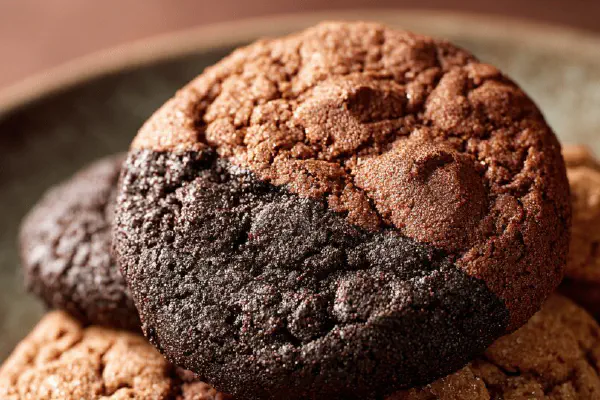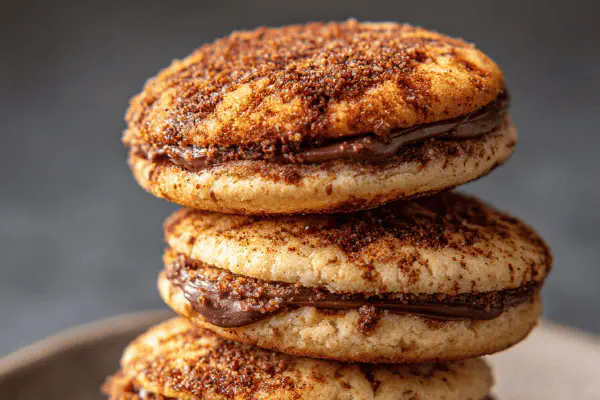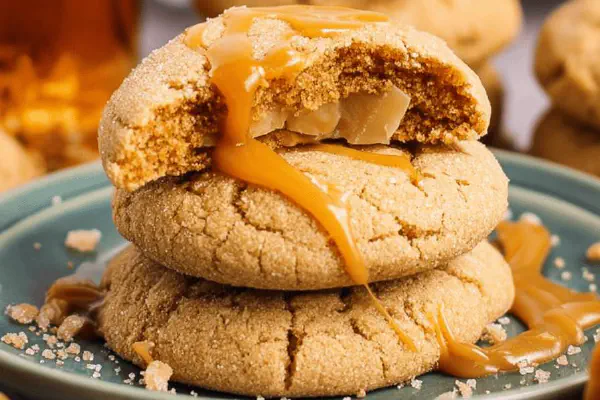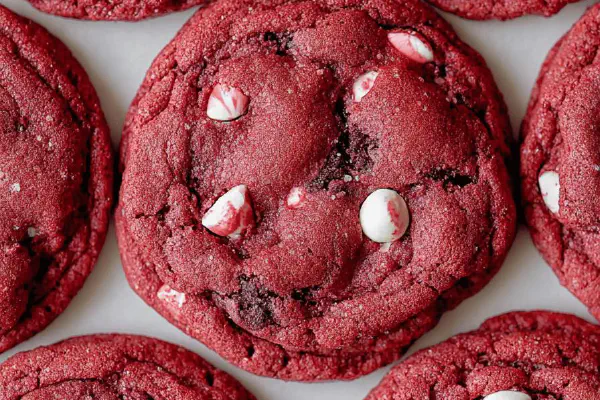Three-Flavor Layered Cookies

By Emma
Certified Culinary Professional
Ingredients
- ¼ batch butter cookie dough
- ½ batch dark chocolate dough
- ½ batch spiced molasses dough (replaces gingerbread)
- Flour for dusting
- Water for brushing
About the ingredients
Method
- Chill all doughs before starting—firm but pliable is key. Avoid room-temp sogginess.
- On a lightly floured surface or between parchment sheets, roll one dough disk into a 30 by 23 cm rectangle about 3 mm thick. Keep edges even or cookies won’t stack clean.
- Brush a very light layer of water over the whole rectangle—just enough to tack the layers but not soak.
- Layer doughs alternately: start with butter, then chocolate, then molasses for a rich stack. Press gently to seal air bubbles but don’t knead in.
- Cut this stack into thirds to get rectangles roughly 23 by 10 cm. Water each cut piece’s surface lightly again. Restack, alternating colors as before, to build contrast in layers.
- Wrap tightly in plastic. Refrigerate 35 minutes minimum to firm up structure and prevent mushy slicing later.
- Preheat oven to 180 °C (350 °F). Position rack mid-oven for even heat.
- Line baking sheets with parchment or silicone mats. This prevents sticking and promotes even browning under the layered edges.
- Slice the chilled layered dough crosswise or lengthwise into 5-6 mm thick strips. Then cut these into small rectangles.
- If dough starts cracking during cutting, press edges gently to rebind; if too soft, chill briefly again. Sharp knives matter here.
- Arrange spaced on sheets; leave breathing room; edges crisp faster when not crowded.
- Slide into oven, bake about 12 minutes but watch color closely. Edges will shift from pale to faint golden; aroma deepens, with a hint of molasses warmth emerging.
- Pull when bottoms show light browning spots and tops feel firm but not darkened.
- Cool fully on rack. They firm up as they cool and develop a delicate snap between layers.
- Store in airtight containers once cold; keeps crisp up to a week.
Cooking tips
Chef's notes
- 💡 Chill doughs fully before rolling—too soft and layers slip or smear. Aim firm but pliable; cold dough rolls cleaner, no stick, no mess. Avoid room temp sogginess; dough that’s warm folds, cracks when stacked. Use parchment or silicone-between sheets for rolling—keeps edges even and thickness constant. Roll slow, don’t rush; uneven layers ruin stacking symmetry and crisp texture later. Dust flour sparingly or edges stiffen. Dust causes rough edges, avoid heavy powder.
- 💡 Water brushing between layers is subtle—too much makes dough soggy, causes spreading in oven. Apply very light coat; fingertip damp or soft brush only. No puddles or soaking. Water tackiness seals layers but overdoing softens stack. If patchy, layers separate mid-bake leaving dry cracks. Brush just enough to bond—watch closely; moisture affects bake times and texture firmness.
- 💡 Cutting chilled dough needs sharp knives—dull blades crush layers, shatter cookies. Slice in two steps: first thirds into big rectangles, water on cuts, restack in alternating colors; then final thin slices. Keep dough cold between cuts; soft dough tears, cracks. Press cut edges gently if cracking starts. If dough softens mid-cut, return stack to fridge quickly 10 minutes or more. Sharp blade and cold dough are key to clean lines and intact layers.
- 💡 Stacking order matters: start with butter dough base, then chocolate, then molasses top layer. This arrangement balances tenderness, bitterness, and spice in each bite. Alternate colors during layering to build visual contrast. Press gently to remove air bubbles but avoid kneading or compressing layers or dough warms, loses structure. Handle stack carefully once layered—soft fingers cause smudging.
- 💡 Baking cues come from senses, not just timer: 180 °C mid-oven placement. Watch edges shift from pale to faint gold; smell deep cocoa and molasses spice aromatic signals readiness. Bake about 12 minutes but ovens vary. Pull cookies when bottoms show light brown spots and tops feel firm but not dark. Baking too long dulls spice aroma and yields brittle texture rather than layered crispness.
Common questions
How firm should dough be before rolling?
Dough firm yet pliable—not brittle or cold-rock. Cool but workable. Soft dough sticks, shrinks layers; cold dough rolls neater. Room temp makes layers merge or soggy. Chill dough until texture feels dense yet bendable. Test by pressing edge; too soft if dent stays. Too cold and cracks on roll; find middle ground.
What if layers separate during baking?
Usually water sealing skipped or too little. Hard edges or too much flour block adhesion. Recheck brush layer next time, thin coat only. Also dough too warm, layers slip before set. Chilling stack longer can help firm. Press gently when layering to squeeze out air pockets causing separation. Cooling fully before cut and bake helps.
Dough cracked when cutting—fix?
Press edges lightly to rebind; soft fingers work better. Chill dough again if too soft mid-cut. Knife needs to be sharp and clean stroke. Slicing in stages reduces strain on dough; cut big slabs first then thin strips. Keep blade warm but not hot or dough sticks. Dust blade lightly with flour if dragging.
Best storage for layered cookies?
Airtight containers once fully cool. Avoid humid spots. Keeps crisp up to a week if stored well. Can freeze dough stacks before cutting—wrap tight, thaw in fridge before slicing. Cookies room temp store better than fridge—fridge adds moisture and softens edges. Layer cookies with parchment sheets if stacking to avoid sticking or breaking.



